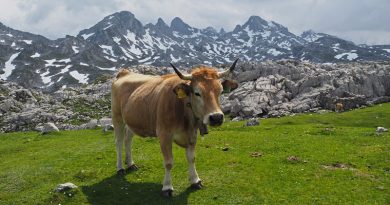Cares Gorge: Is this Spain’s best one-day walk?
Claiming something is the best is always risky.
That’s especially true when you don’t know all the other contenders, and I definitely haven’t done all the one-day walks in Spain. Truth be told, I’ve only done a couple.
And even when such claims are probably true — think of the Tongariro Crossing, said to be the best one-day walk in New Zealand — they can have unintended consequences. Before the Covid-19 pandemic as many as 3000 people walked the Tongariro Crossing every day in summer, so many that I’d started telling friends to avoid it.
All the same, the Cares Trail, or Ruta del Cares in Spanish, would have to be a strong candidate for the title of Spain’s best one-day walk.
It follows the Cares River as its slices through the middle of the Picos de Europa mountain range in northern Spain, creating a gorge up to 1.5km deep.
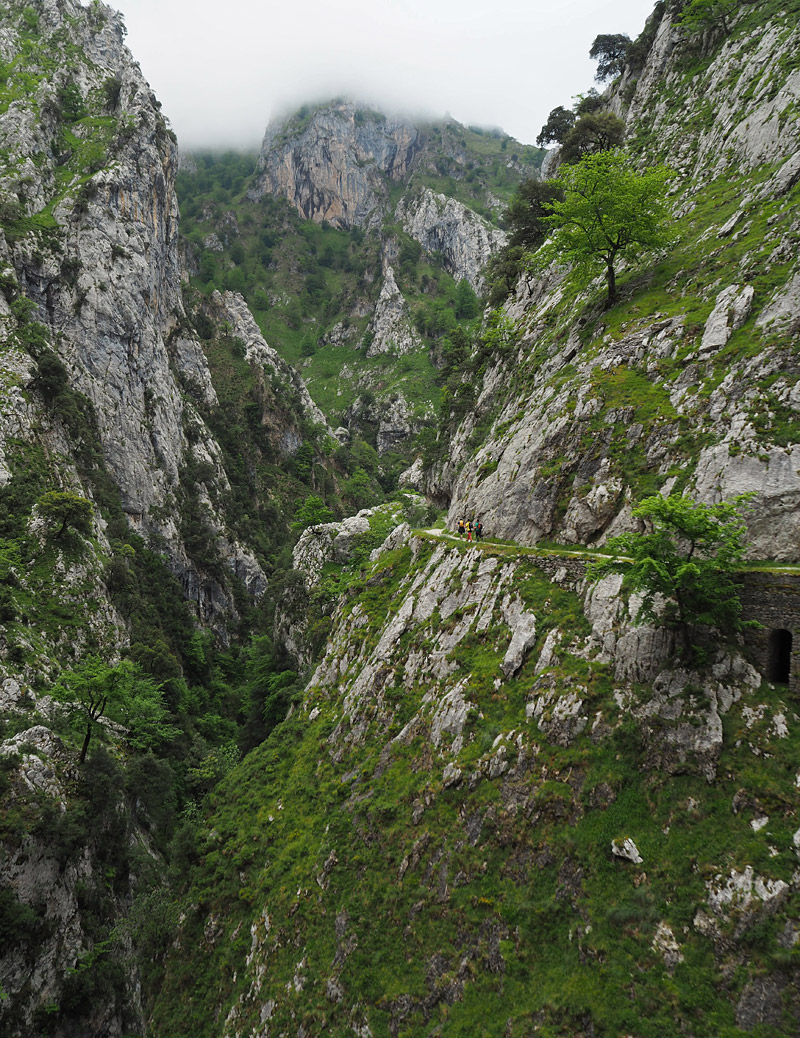
The gorge, Garganta del Cares in Spanish, would be impassable but for a canal carved into its sheer limestone walls in 1916-21.
An extraordinary feat of engineering, the canal was built to divert part of the river’s flow to a hydroelectric power station.
The trail was built to allow workers to maintain the canal and carry supplies up the gorge. At times the trail is right next to the canal, but sometimes the canal is far below or vanishes into a tunnel bored through the mountains.
In places the track is little more than a notch cut into the cliffside; elsewhere the trail builders carved tunnels with windows cut through the rock to let light in, like the Windows Walkway in New Zealand’s Karangahake Gorge (a historic trail built for gold miners in the late 1800s).
The gorge itself is intensely green and vertiginously steep. As you climb into its upper reaches it becomes steadily more spectacular; by the time you approach Caín, the village that marks the end point of the walk, the distance from the Rio Cares gurgling at the bottom of the gorge to the limestone peaks at the top is about 1.5km. The river is so far down it flows through a damp, ferny microclimate rarely touched by the sun.
Whichever way you look there’s nothing but raw, jaw-dropping beauty. After a while I just didn’t know where to look or what to photograph.

Practicalities
The Cares Trail (Ruta del Cares) is between 11km and 15km long, depending on who you believe. It takes about three hours each way but you should allow more for an extended lunchbreak and staring dumbfounded at the scenery.
It starts at Poncebos, a village on the northern side of Picos de Europa National Park (Parque Nacional de Picos de Europa) and ends at the village of Caín.
The first 40 minutes from Poncebos is an uphill slog on terrain which is rocky and sometimes uneven, but once you reach the canal path the gradient is so gentle you barely notice you’re going uphill.
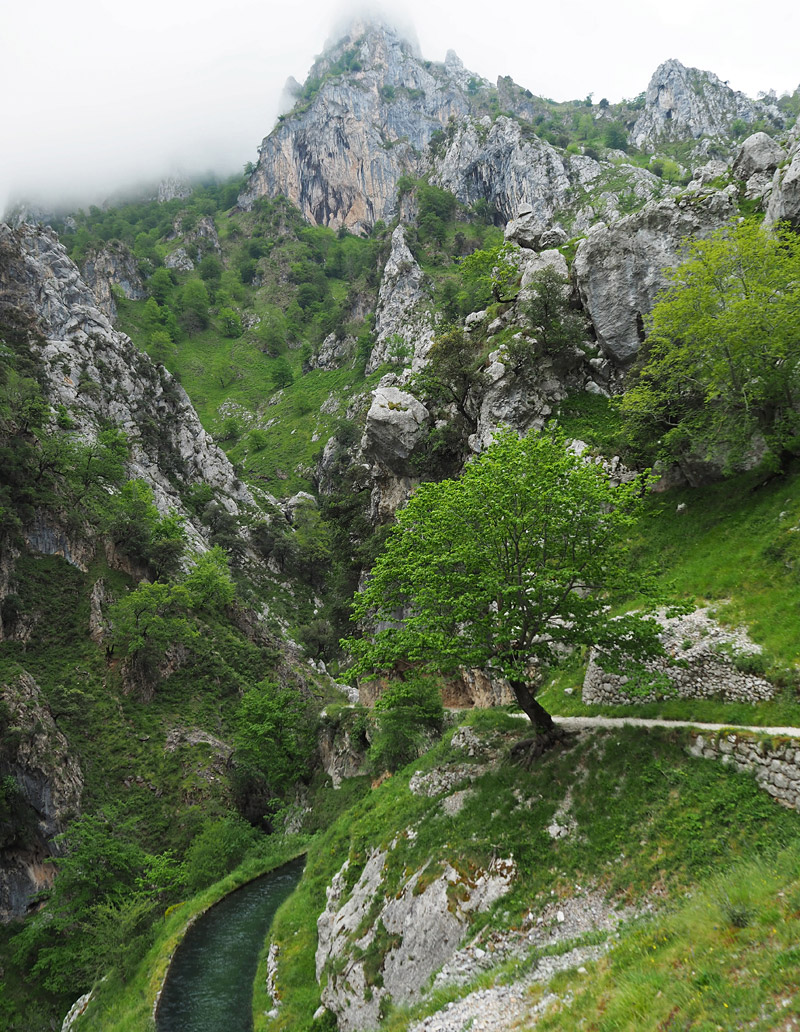
The gravel path is wide and quite safe but there’s no handrail and in places it’s as much as 200m above the river, so it isn’t recommended for people who have trouble with vertigo. It gets busy and can be a little nerve wracking if a group coming the other insists on walking two abreast.
The further you ascend into the gorge the more spectacular the scenery becomes until you finally emerge at Caín. The village has several places you can get a hearty Spanish meal. It’s touristy but you can still eat well for about €10.
In summer it is apparently possible to get a taxi from Caín back to the starting point. However, this involves driving all the way around the national park and paying a small fortune. It is probably more enjoyable, not much slower and definitely a lot cheaper to walk back the way you came, making a round trip of about six to seven hours.
Normally I’m not a fan of returning by the same route but the gorge is so beautiful I think it’s worth doing twice, plus you’ll see things you missed on the way up.
I returned late in the day so the trail was almost deserted on the way down. As soon as the hikers are gone the goats move in. They’re everywhere, doing goaty things like perching on top of rocks and blocking tunnels so you have to ask them politely to step aside.
Getting there
The nearest major town is Cangas de Onís. It has a useful national park office — English is limited but the staff make up for it with willingness — and plenty of shops for provisions and restaurants offering Menú del día. These daily lunch specials are huge, inexpensive and often include a complementary carafe of wine.
-
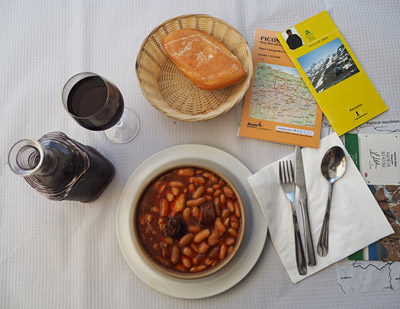
Asturian bean stew makes ideal hiking fuel.
Cangas also has a few sights such as a picturesque 13th century stone bridge.Cangas de Onís is well connected to major cities by public transport. Buses run hourly from Oviedo (1 hr 30 min, 70km), the capital of Asturias province. There are also regular buses from Santander in the Basque Country.
From Cangas de Onís there are regular buses to the village of Arenas de Cabrales (30km); I didn’t find any public transport from Arenas de Cabrales to the start of the trail at Poncebos but it’s only 6km, making it a quick taxi ride or an easy hitch-hike.
Both Oviedo and Santander have plenty of car rental options.
Where to stay
If you want to stay for the night Poncebos has one hotel, Hostal de Poncebos, superbly located by the river and the Bulnes funicular. Prices start around €30 (NZ$54) for a basic but comfortable single with shared bathroom. Arenas de Cabrales and Cangas de Onís have more accommodation options.
I’d planned to sleep under the stars after my walk but once drizzle set in I found a dry cave with a view of the river.
When to go
The Cares Trail is walked by about 300,000 people a year. That’s more than double the numbers on the Tongariro Crossing and makes it very busy in summer. It’s best to go in spring or autumn or get an early start.
What to bring
The Cares Trail is hardly a wilderness walk but you’ll still need water and decent shoes for the gravelly terrain. It can rain any time of year in the mountains so best to be prepared for that too. Bring extra provisions if you go in the off-season because the restaurants in Caín may not be open.
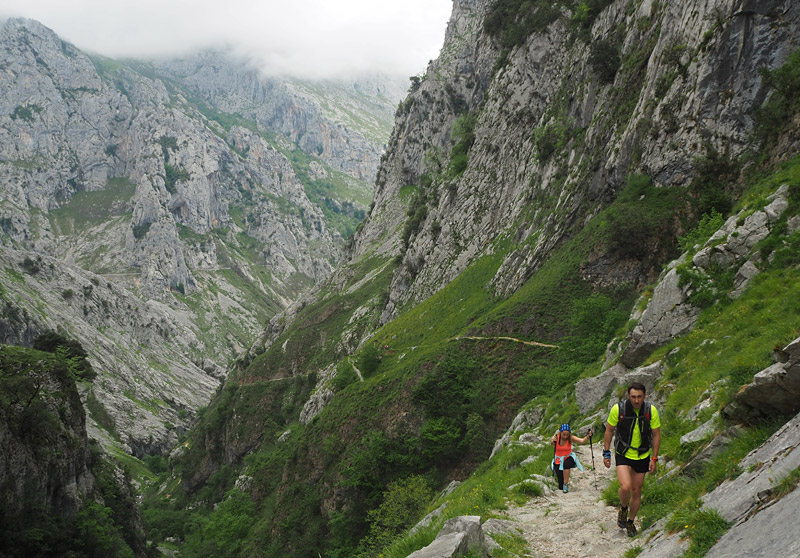
Other walks: Bulnes Gorge
Picos de Europa National Park boasts many other fabulous trails, including multi-day walks around the iconic Naranjo de Bulnes. At 2519m this is not the highest peak in the park but it is topped by a 500m-high trapezoid of bare limestone, making it improbably dramatic.
If you have some free time in Poncebos it’s well worth doing a half-day walk in the Bulnes Gorge, in the next valley east of the Cares Gorge.
You can walk up the gorge to the village of Bulnes in about 1.5 hours — note that the zig-zag track is steep in places and traverses loose rock — or you can take the funicular railway instead.
For centuries the only way of getting to Bulnes was on foot and the village was often abandoned in winter during heavy snow.
-
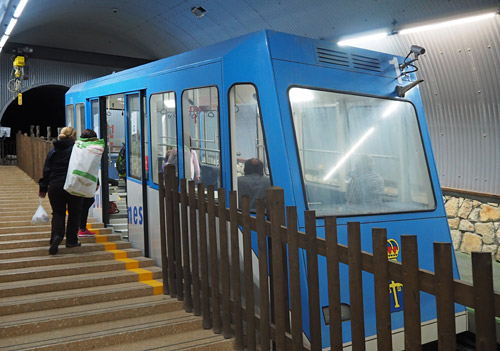
The Bulnes funicular. Photo: Peter de Graaf
That was until 2001, when the provincial government of Asturias bored a tunnel through the mountain and built a funicular railway.
The funicular, which is like a tram pulled uphill on a cable, isn’t cheap at €17 (2016 price) and you don’t get any views because you’re in a tunnel, but it’s an enjoyable novelty, especially for public transport geeks. It is 2.2km long with an 18 degree gradient and a 400m elevation gain.
You can then explore the village, which has a lookout offering views of Naranjo de Bulnes in clear weather, and hike back down to Poncebos.
I would, however, offer one bit of advice about the Bulnes Gorge. In normal circumstances this would be a spectacular walk — unless, as I did, you walked the Cares Gorge the day before. The Cares Gorge is so spectacular anything else pales in comparison.
So if you’re going to do both I’d walk the Bulnes Gorge first, then the Cares Gorge. That way you’ll be amazed by both.
If you are fit, have a map and know what you’re doing, you can continue from Bulnes on a demanding eight-hour loop via Naranjo de Bulnes and the village of Sotres, then back to Poncebos by road. If you stay overnight in a refugio (mountain hut) to buy yourself more time you can take a longer route from Sotres back to Poncebos via the mountains. You can read a detailed description in this excellent hikers’ blog called The Sandy Feet.


